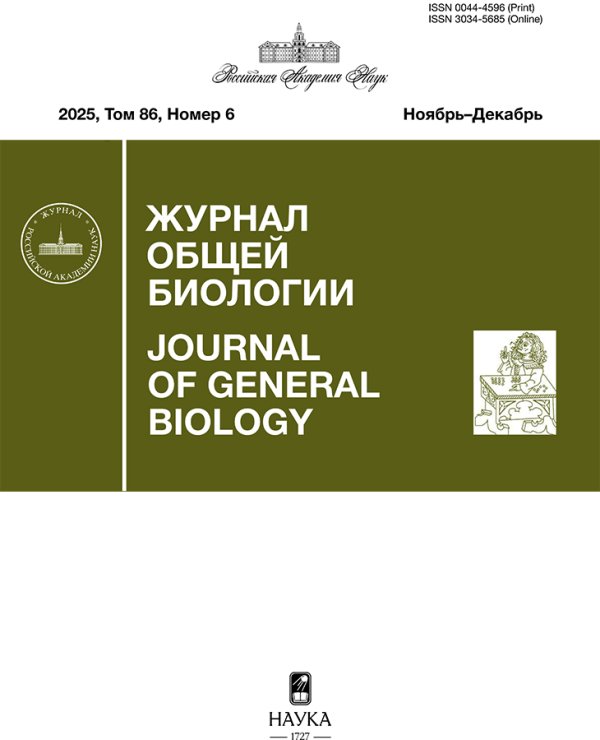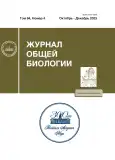The pattern of natural variability of palynomorphological features with the example of some Nierembergia and Bouchetia species (Solanaceae) and natural system of bio-variety
- Authors: Pozhidaev A.E.1, Grigoryeva V.V.1, Semyonov A.N.1
-
Affiliations:
- Komarov Botanical Institute, RAS
- Issue: Vol 84, No 4 (2023)
- Pages: 279-295
- Section: Articles
- URL: https://journals.rcsi.science/0044-4596/article/view/148103
- DOI: https://doi.org/10.31857/S0044459623040061
- EDN: https://elibrary.ru/DLLKAU
- ID: 148103
Cite item
Full Text
Abstract
On the example of pollen morphological features of 8 species of Nierembergia and 2 species of Bouchetia (family Solanaceae), the properties of individual variability are described. Most of the studied characters (structure of apertures, ultrastructure of the sporoderm, surface sculpture, dimensions) do not have significant differences at the individual and intraspecific levels; taxonomically significant variability of morphological features of pollen is manifested at the level of the genus and suprageneric groups. The genera differ significantly in the sculpture of the pollen grain surface – striate in Nierembergia and tuberculate in Bouchetia. Pollen contained in one bud, anther or tetrad (fully completed gametophytic generation, where there is no death – all descendants of one ancestor without exception), is considered as an extreme model (maximum completeness with minimum complexity) to study the properties of natural morphological variability and the causes of its occurrence. It was found that pollen characters (sculpture, number and location of apertures) have the same pattern of variability (continuous and transitively ordered series), which embodied at different taxonomic levels in different characters. The natural variability of pollen morphological features is ordered not into a genealogical clade, but into a cline – continuous, geometrically ordered and transitive series (taxon-nonspecific and rank-independent). In this system of parallelisms, homological series are inseparable from non-homological ones, and typical forms, from deviations. The origin of typical and deviant forms cannot be explained separately (typical – genealogically, and deviant – as parallelism, convergence, chance or regularity). The individual variability of pollen forms is geometrically ordered and is not the result of random disturbances, failures of the hereditary program, or pathology. The typical form turns out to be a harmonious part of a geometrically ordered series of pure forms, free from functional and historical connotations. The similarity of pollen forms in these series is determined by their geometry and does not depend on affinity, homology, functionality (improvement, exercise, adaptation). The natural system of pollen forms is formed not by the structure of supposed affinity of supposed taxa (universalia, general concepts, the result of speculation that requires confirmation and admits refutation), but the structure of the observed parallelisms of the variability of individual living bodies. Evolutionary novelty (the current state, the observed variability) arises initially ordered in a pre-established form.
About the authors
A. E. Pozhidaev
Komarov Botanical Institute, RAS
Author for correspondence.
Email: pae62@mail.ru
Russia, 197376, Saint Petersburg,
Prof. Popov St., 2
V. V. Grigoryeva
Komarov Botanical Institute, RAS
Author for correspondence.
Email: grigorieva@binran.ru
Russia, 197376, Saint Petersburg,
Prof. Popov St., 2
A. N. Semyonov
Komarov Botanical Institute, RAS
Email: grigorieva@binran.ru
Russia, 197376, Saint Petersburg,
Prof. Popov St., 2
References
- Архангельский Д.Б., 1982. Морфологические типы пыльцевых зерен современных цветковых // Бот. журн. Т. 67. № 7. С. 890–897.
- Берг Л.С., 1922. Номогенез или эволюция на основе закономерностей. Петроград: Гос. изд-во. 306 с.
- Бунге М., 2010. Причинность. Место принципа причинности в современной науке. М.: URSS. 512 с.
- Гете И.В., 2014. Научные сочинения. Т. 1. Образование и преобразование органических существ (морфология). М.: КМК. 696 с.
- Григорьева В.В., Брицкий Д.А., Коробков А.А., 2018. Морфология пыльцевых зерен видов рода Artemisia (Asteraceae) Дальнего Востока России // Бот. журн. Т. 103. № 10. С. 1255–1264. https://doi.org/10.7868/S0006813618100046
- Григорьева В.В., Пожидаев А.Е., Семенов А.Н., Брицкий Д.А., 2019. Морфологическая изменчивость пыльцы представителей рода Nicotiana (Solanaceae) // Бот. журн. Т. 104. № 6. С. 900–917. https://doi.org/10.1134/S0006813619060061
- Данилевский Н.Я., 2015. Дарвинизм. Критическое исследование. М.: ФИВ. 976 с.
- Кремп Г.О.И., 1967. Палинологическая энциклопедия. М.: Мир. 335 с.
- Кренке Н.П., 1933–1935. Феногенетическая изменчивость // Сборник работ отделения фитоморфогенеза. Т. I. М.: Изд. Биол. ин-та им. Тимирязева. С. 11–415.
- Куприянова Л.А., Алешина Л.А., 1967. Палинологическая терминология покрытосеменных растений. Л.: Наука. 84 с.
- Куприянова Л.А., Алешина Л.А., 1972. Пыльца и споры растений флоры европейской части СССР. Т. 1. Л.: Наука. С. 48–51.
- Любарский Г.Ю., 2018. Происхождение иерархии: история таксономического ранга. М.: КМК. 659 с.
- Любищев А.А., 1982. Проблемы формы, систематики и эволюции организмов. М.: Наука. 376 с.
- Манукян Л.К., 1975. Палинология рода Sideritis L. // Палинология. Ереван: Изд-во АН АрмССР. С. 40–44.
- Мейен С.В., 1978. Основные аспекты типологии организмов // Журн. общ. биологии. Т. 39. № 4. С. 495–508.
- Оскольский А.А., 2001. О феноменологии биологического сходства // Гомологии в ботанике: опыт и рефлексия / Ред. Оскольский А.А., Соколов Д.Д., Тимонин А.К. СПб.: Санкт-Петербургский союз ученых. С. 115–133.
- Павлинов И.Я., 2019. Биологическая систематика: в поисках естественной системы. М.: КМК. 246 с.
- Пожидаев A.E., 1989. Структура экзины пыльцевых зерен представителей сем. Lamiaceae // Бот. журн. Т. 74. № 10. С. 1410–1422.
- Пожидаев А.Е., 2009. Структура многообразия морфологического признака на примере расположения апертур пыльцы цветковых и естественная упорядоченность биологического многообразия. Или – что такое многообразие (описание и интерпретация) // Вид и видообразование. Анализ новых взглядов и тенденций. Тр. ЗИН РАН. Приложение № 1. М.: КМК. С. 151–182.
- Пожидаев А.Е., 2015. Рефренная структура биологического многообразия и теория филогенеза // Палеоботанический временник. Вып. 2. М.: ГЕОС. С. 115–127.
- Пожидаев А.Е., Григорьева В.В., Семенов А.Н., 2024. Структура индивидуальной изменчивости палиноморфологических признаков рода Cestrum (Solanaceae Juss.). Типичная форма и отклонения (морфозы) // Журн. общ. биологии. В печати.
- Пожидаев А.Е., Петрова Н.В., 2022. Структура изменчивости палиноморфологических признаков внутри рода Galeopsis l. Hjl. (Lamiaceae) и за его пределами в связи с идеей дивергентной морфологической эволюции // Журн. общ. биологии. Т. 83. № 3. С. 151–169.
- Поздняков А.А., 2015. Философское обоснование классической биологии: Механицизм в эволюционистике и систематике. М.: ЛЕНАНД. 304 с.
- Раутиан А.С., 2001. Апология сравнительного метода: о природе типологического знания // Гомологии в ботанике: опыт и рефлексия / Ред. Оскольский А.А., Соколов Д.Д., Тимонин А.К. СПб.: Санкт-Петербургский союз ученых. С. 73–80.
- Чайковский Ю.В., 2018. Автопоэз. М.: КМК. 560 с.
- Шелудякова М.Б., Григорьева В.В., Пожидаев А.Е., 2017. Морфология пыльцевых зерен представителей рода Scrophularia (Scrophulariaceae) // Бот. журн. Т. 102. № 3. С. 361–379.
- Blackmore S., Crane P.R., 1998. The evolution of apertures in the spores and pollen grains of embryophytes // Reproductive Biology / Eds Owens S.J., Rudall P.J. Kew: Royal Botanic Gardens. P. 159–218.
- Campo M., van, 1976. Patterns of pollen morphological variation within taxa // The Evolutionary Significance of the Exine / Eds Ferguson I.K., Muller J. L.: Academic Press. P. 125–137.
- Cocucci A.A., 2013. Nierembergia // Flora Argentina. V. 13. Dicotyledoneae. Solanaceae. Buenos Aires: Instituto de Botánica Darwinion. P. 149–150.
- Erdtman G., 1952. Pollen Morphology and Taxonomy: Angiosperms. Stockholm: Almquist and Wiksell. 539 p.
- Finot V.L., Marticorena C., Marticorena A., 2018. Pollen grain morphology of Nolana L. (Solanaceae: Nolanoideae: Nolaneae) and related genera of southern South American Solanaceae // Grana. V. 57. № 6. P. 415–455. https://doi.org/10.1080/00173134.2018.1458897
- Gavrilova O., Britski D., Grigorieva V., Tarasevich V., Pozhidaev A., Leunova V., 2018. Pollen morphology of the genus Euonymus (Celastraceae) // Turczaninowia. V. 21. № 4. P. 188–206. https://doi.org/10.14258/turczaninowia.21.4.20
- Hayrapetyan A.M., 2008. Features of the exine ornamentation of pollen grains in the family Solanaceae Juss. I. The simple types of ornamentation // Nat. Sci. V. 2. № 11. P. 46–50.
- Hofman C.C., Zetter R., 2007. Upper Cretaceous pollen flora from the Vilui basin, Siberia: Circumpolar and endemic Aquilapollenites, Manicorpus, and Azonia species // Grana. V. 47. № 4. P. 227–249. https://doi.org/10.1080/00173130701763142
- Hunziker A.T., 2001. Genera Solanacearum: The Genera of Solanaceae Illustrated, Arranged According to a New System. Liechtenstein: Ruggell. 500 p.
- Huynh K., 1972. Le pollen et la systematique du genere Sideritis L. (Labiatae) // Bull. Mus. Nat. Hist. Nat. 3 ser. № 45. Bot. 1. P. 1–28.
- In Memoriam. С.В. Мейен: палеоботаник, эволюционист, мыслитель, 2007. М.: ГЕОС. 348 с.
- Meyen S.V., 1973. Plant morphology in its nomothetical aspects // Bot. Rev. V. 39. № 3. P. 205–260.
- Peyrot D., Barrön E., Comas-Rengifo M.J., Touand E., Tafforeau P., 2007. A confocal laser scaning and conventional wide field light microscopy study of Classopollis from the Torcian-Aalenian of the Fuentelsaz section (Spain) // Grana. V. 46. № 4. P. 217–226.
- Pire S.M., Dematteis M., 2007. Pollen aperture heteromorphism in Centaurium pulchellum (Gentianaceae) // Grana. V. 46. № 1. P. 1–12.
- Pozhidaev A.E., 1993. Polymorphism of pollen in the genus Acer (Aceraceae). Isomorphism of deviant forms of Angiosperm pollen // Grana. V. 32. № 1. P. 79–85. https://doi.org/10.1080/00173139509429028
- Pozhidaev A.E., 1995. Pollen morphology of the genus Aesculus (Hippocastanaceae). Patterns in the variety of morphological characteristics // Grana. V. 34. № 1. P. 10–20. https://doi.org/10.1080/00173139509429028
- Pozhidaev A.E., 1998. Hypothetical way of pollen aperture patterning. 1. Formation of 3-colpate patterns and endoaperture geometry // Rev. Palaeobot. Palynol. V. 104. № 1. P. 67–83.
- Pozhidaev A.E., 2000a. Hypothetical way of pollen aperture patterning. 2. Formation of polycolpate patterns and pseudoaperture geometry // Rev. Palaeobot. Palynol. V. 109. № 3–4. P. 235–254. https://doi.org/10.1016/s0034-6667(99)00057-3
- Pozhidaev A.E., 2000b. Pollen variety and aperture patterning // Pollen and Spores: Morphology and Biology / Eds. Harley M.M., Morton C.M., Blackmore S. Kew: Royal Botanic Gardens. P. 205–225.
- Pozhidaev A.E., 2002. Hypothetical way of pollen aperture patterning. 3. A family-based study of Krameriaceae // Rev. Palaeobot. Palynol. V. 127. № 1–2. P. 1–23. https://doi.org/10.1016/S0034-6667(02)00251-8
- Shishova M., Puzanskiy R., Gavrilova O., Kurbanniazov S., Demchenko K. et al., 2019. Metabolic alterations in male-sterile potato as compared to male-fertile // Metabolites. V. 9. № 2. Art. 24. https://doi.org/10.3390/metabo9020024
- Stafford P., Knapp S., 2006. Pollen morphology and systematics of the zygomorphic flowered nightshades (Solanaceae; Salpiglossideae sensu D’Arcy, 1978 and Cestroideae sensu D’Arcy, 1991, pro parte): A review // Syst. Biodivers. V. 4. № 2. P. 173–201. https://doi.org/10.1017/S1477200005001787
- Tate J.A., Acosta M.C., McDill J., Moscone E.A., Simpson B.B., Cocucci A.A., 2009. Phylogeny and character evolution in Nierembergia (Solanaceae): Molecular, morphological, and cytogenetic evidence // Syst. Bot. V. 34. № 1. P. 198–206. https://doi.org/10.1600/036364409787602249
- Walker J.W., Doyle J.A., 1975. The bases of angeosperms phylogeny: Palynology // Ann. Miss. Bot. Gard. V. 62. № 3. P. 664–723. https://doi.org/10.2307/2395271
- Wodehouse R.P., 1935. Pollen Grains: Their Structure, Identification and Significance in Science and Medicine. N.-Y.; L.: McGraw-Hill. 574 p.
Supplementary files














